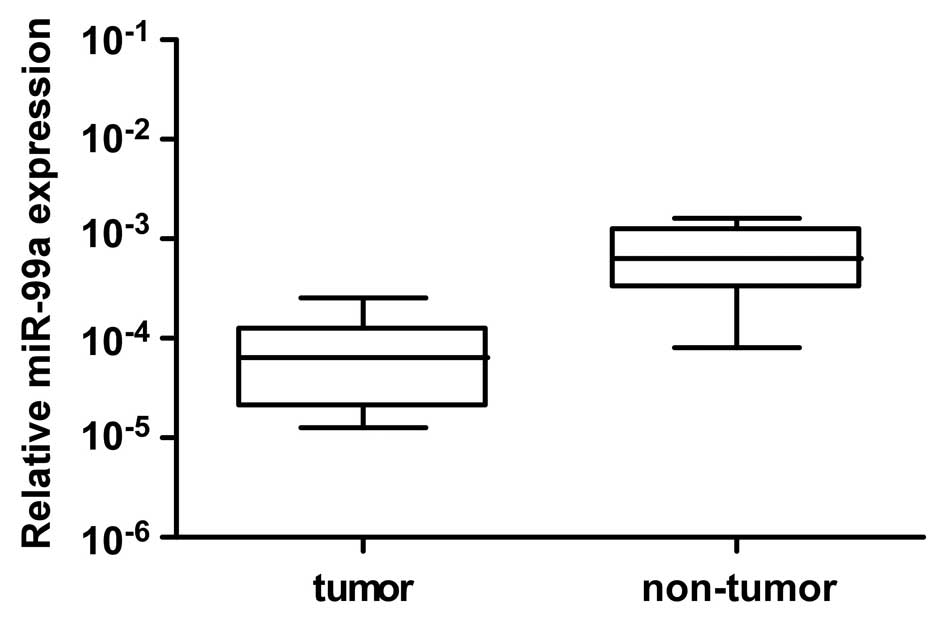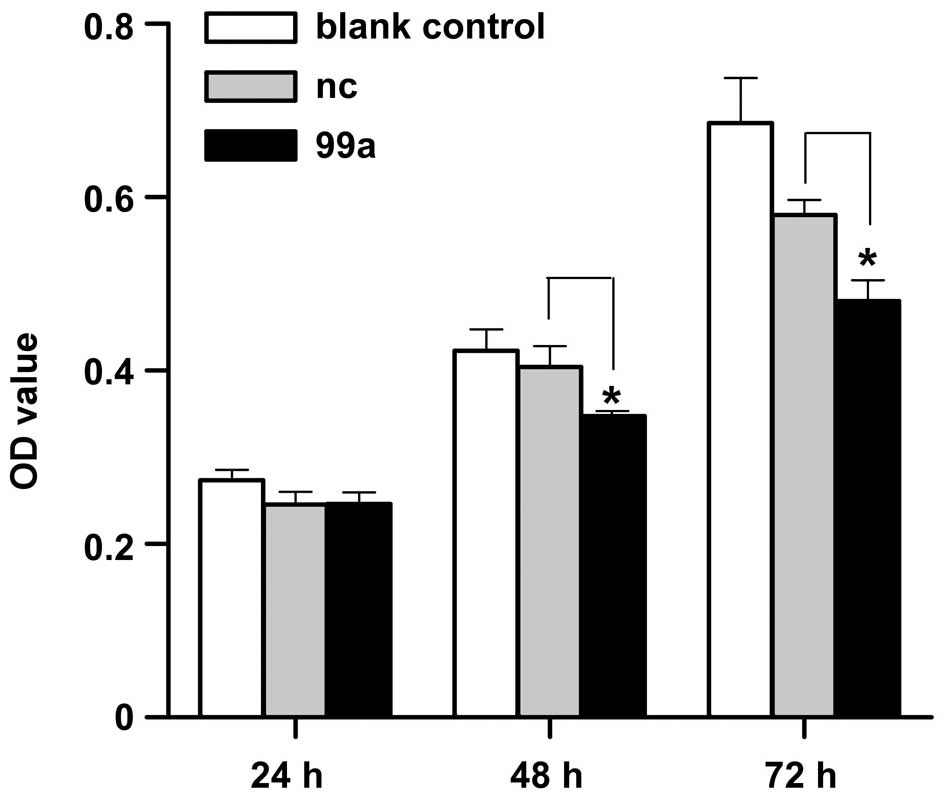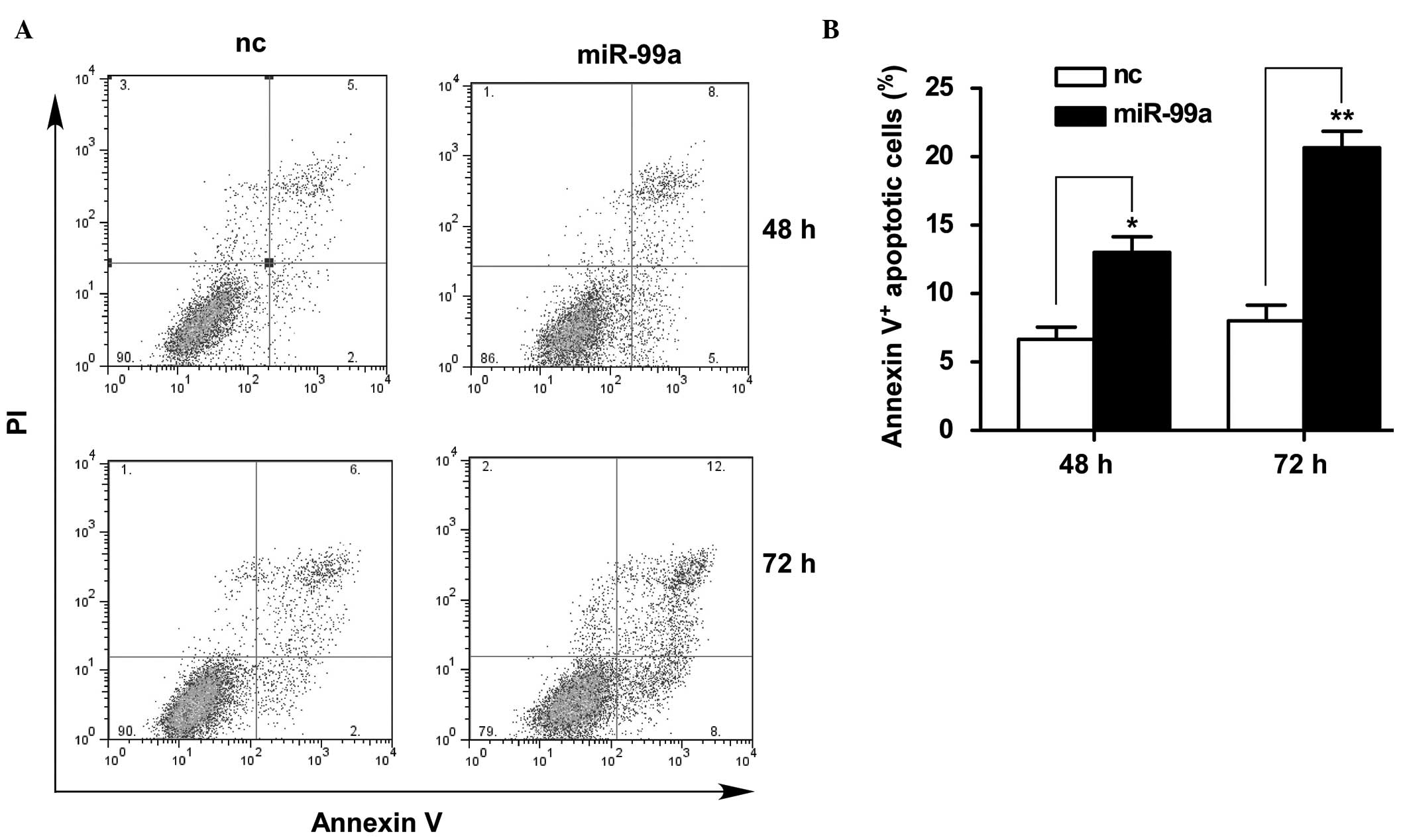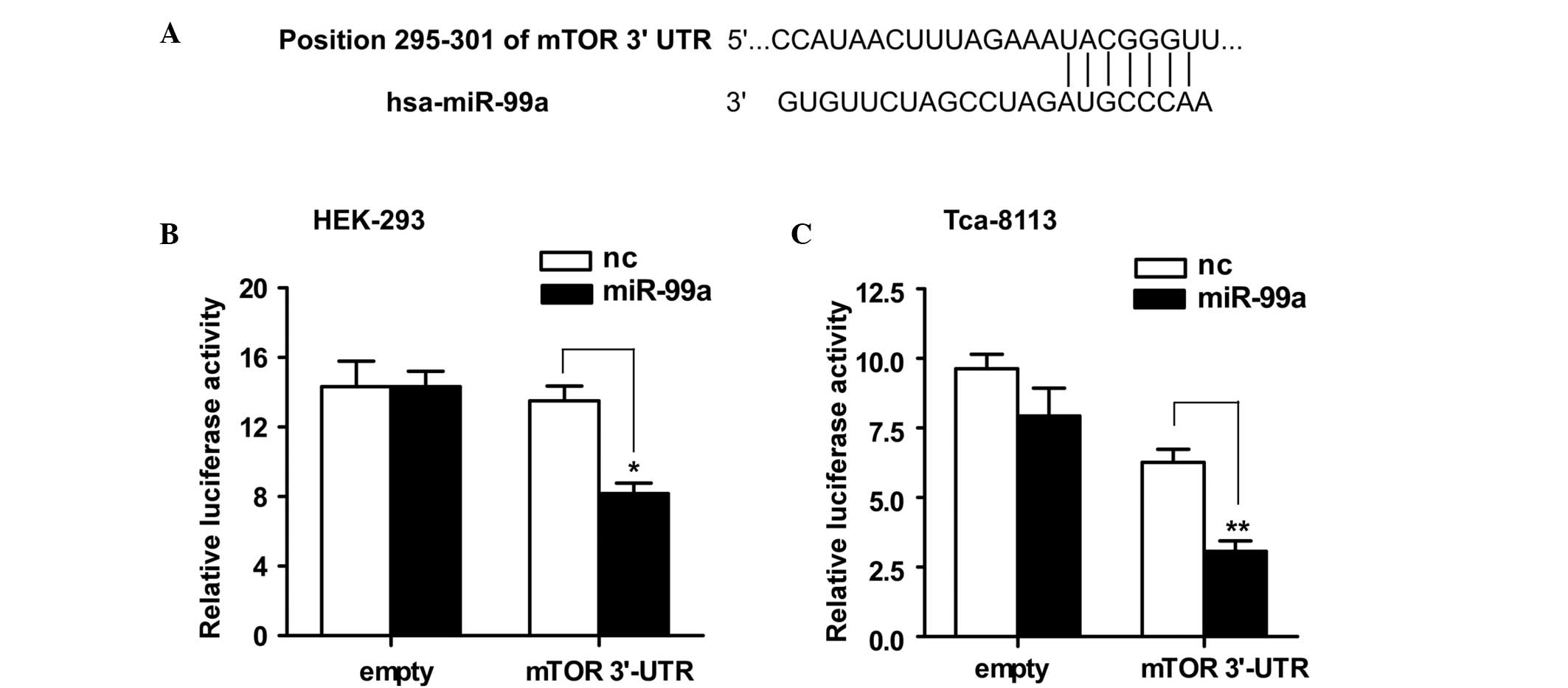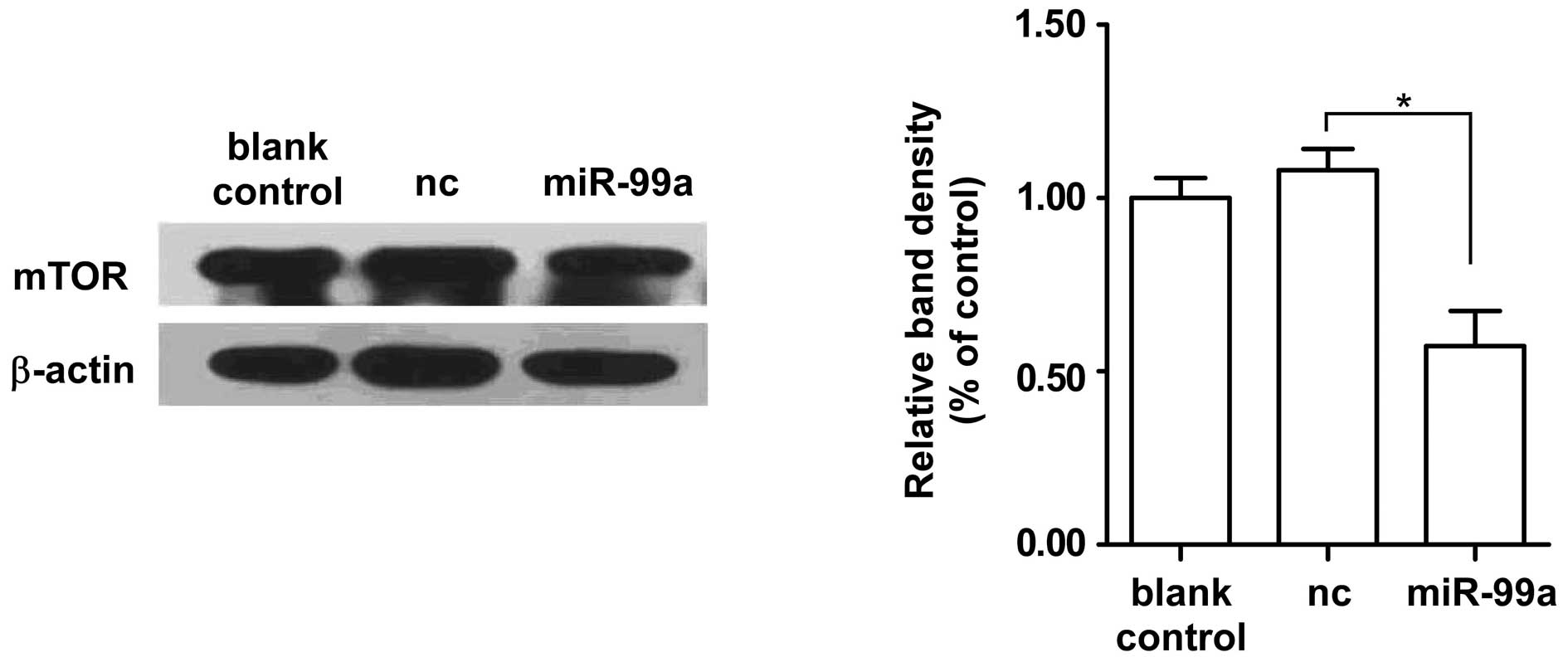Downregulation of microRNA 99a in oral squamous cell carcinomas contributes to the growth and survival of oral cancer cells
- Authors:
- Published online on: June 27, 2012 https://doi.org/10.3892/mmr.2012.971
- Pages: 675-681
Abstract
Introduction
MicroRNAs (miRNAs) are short regulatory RNA molecules with an average length of 22 nucleotides. When miRNAs are integrated into RNA-induced silencing complexes, the molecules bind to a partially complementary sequence in the 3′-untranslated regions (3′-UTRs) of target mRNAs and regulate gene expression by inhibiting translation and destabilizing transcripts (1). Beyond the involvement in diverse biological processes, including cell growth, apoptosis (2), development (3), differentiation (4) and endocrine homeostasis (5), it has been well demonstrated that the deregulation or dysfunction of miRNAs contributes to cancer development. In recent years, large high-throughput studies in patients revealed that miRNA profiling has the potential to classify tumors with high accuracy. In addition, miRNA alterations have been reported to be associated with specific clinical phenotypes, including disease progression or recurrence, development of metastases and post-operative outcome. The results of functional studies, some of which involved animal models, indicate that miRNAs act as tumor suppressors and oncogenes (6). It has been proposed that alterations in miRNA genes play a critical role in the pathophysiology of various types of human cancer (7).
Oral squamous cell carcinomas (OSCCs) account for over 40% of head and neck malignancies and rank sixth worldwide in incidence. OSCCs have a particularly poor prognosis due to their invasive nature. Despite advances in the fields of oncology and surgery, the five-year survival rates of OSCC are less than 50% and have remained unchanged in the last three decades (8). New molecular insights into the mechanisms of cancer formation and progression are likely to aid the improvement of diagnosis and prognosis and the development of new therapies for treating oral cancer.
Using microarrays or quantitative reverse transcription-polymerase chain reaction (qRT-PCR), a number of studies have analyzed miRNA expression profiles in OSCC and head and neck squamous cell carcinoma (HNSCC) (9). Certain functional studies have revealed miRNA-regulated pathways in OSCC proliferation or apoptosis, metastasis and chemoresistance. miRNA (miR)-21 is overexpressed and exhibits oncogenic activity in various carcinomas, including OSCC (10). The high expression of miR-21 was found to be associated with low levels of tropomyosin 1 (TPM1) and phosphatase tensin homolog (PTEN) expression and reduced cell apoptosis (10). The overexpression of miR-184 was confirmed in tongue squamous cell carcinoma (TSCC) tissues. The inhibition of miR-184 was able to reduce TSCC cell proliferation while suppressing miR-184 induced cell apoptosis. Plasma miR-184 levels were significantly higher in TSCC patients compared with normal individuals and the levels were significantly reduced following the surgical removal of the primary tumors (11). miR-133a, −133b, −137, −193a, −125b and −100 are frequently downregulated in OSCC (12). In addition, a recent study showed that reduced levels of miR-138 and miR-222 were correlated with the enhanced metastatic potential of TSCC (13). These deregulated miRNAs have potential as novel diagnostic, prognostic and therapeutic tools, which are expected to advance the clinical management of OSCC in the near future.
However, the role of miR-99a in OSCC development remains unknown. In the present study, we investigated the roles of miR-99a in OSCC development and the underlying mechanisms.
Materials and methods
Cell line
The human OSCC cell line Tca-8113 was routinely maintained in the Institute of Immunology, Zhejiang University School of Medicine (Hangzhou, China). Tca-8113 cells were cultured in RPMI-1640 medium, supplemented with 10% (v/v) fetal bovine serum (FBS), 100 U/ml penicillin and 100 U/ml streptomycin at 37°C in a humidified atmosphere containing 5% CO2.
Patients and samples
Surgical samples of 25 human primary OSCC tissues and 25 tumor-free tissues were obtained during the surgical resection of OSCC patients and immediately frozen in liquid nitrogen and stored at −80°C until analysis. Patients with primary OSCC treated between 2008 and 2010 in the Department of Oral and Maxillofacial Surgery, Ningbo First Hospital (Ningbo, China), were studied with the approval of the local Ethics Committee. The patients included in the present study: i) were primary OSCC patients confirmed by pathology following surgery; ii) did not undergo radiotherapy, chemotherapy or immunotherapy prior to surgery; iii) had complete clinicopathological data available. The tissue samples were from the following sites: tongue (20), mouth floor (4) and gingiva (1). The histology of the tissues was evaluated by the hospital's pathologist. Histological grading was performed according to the World Health Organization classification. Samples were collected only after receiving informed consent from the patients.
RNA isolation and real-time qPCR
For RT-PCR, total RNA of tumor and tumor-free tissues was isolated using TRIzol reagent (Invitrogen, Carlsbad, CA, USA) according to the manufacturer's instructions. Real-time qPCR, using SYBR-Green detection chemistry (Takara Bio Inc., Shiga, Japan), was performed on a 7500 Real-Time PCR system (Applied Biosystems, Carlsbad, CA, USA). For miRNA analysis, the RT primer for miR-99a was 5′-GTCGTATCCAGTGCAGGGTCCGAGGTATTCGCACTGGATACGACCACAAG-3′. The qPCR primers were 5′-GGAACCCGTAGATCCGAT-3′ (forward) and 5′-GTGC AGGGTCCGAGGT-3′ (reverse). U6 small nuclear RNA was quantified using its reverse primer for the RT reaction and its forward and reverse primers for qPCR, which were 5′-CTCGCTTCGGCAGCACA-3′ (forward) and 5′-AACG CTTCACGAATTTGCGT-3′ (reverse). Quantitative measurements were determined using the ΔΔCt method and the expression of U6 was used as the internal control.
Transfection of miR-99a mimics and MTT assay
miR-99a mimics and controls obtained from GenePharma (Shanghai, China) were used for the overexpression of miR-99a activity in cells. The cells were transfected with RNAs at a final concentration of 20 nM. JetSI-ENDO transfection reagents (Polyplus-transfection, Illkirch, France) were used for the transfection of RNAs, according to the manufacturer's instructions.
The growth of Tca-8113 cells following miR-99a treatment was examined using an MTT assay. The cells were subcultured in 96-well plates at a density of 1×104 cells/well, transfected with miR-99a mimics or control mimics (at a final concentration of 20 nM) and cultured for 24, 48 or 72 h. The medium was then removed and 20 μl of MTT (5 mg/ml in PBS) was added to the fresh medium. Following a 2-h incubation at 37°C, 100 μl DMSO was added to each well and the plates were agitated for 1 min. The spectrophotometric absorbance at 570 nm was measured. The experiments were performed independently a minimum of three times.
Detection of cell apoptosis by FACS analysis
Following the treatment with miR-99a mimics or control mimics for 48 or 72 h, the harvested cells were suspended in 100 μl binding buffer (1X), including 1 μl Annexin V-FITC and 10 μl PI for 15 min in the dark at room temperature, and 400 μl binding buffer (1X) was added to each sample. The FITC and PI fluorescence were measured through FL-1 filter (530 nm) and FL-2 filter (585 nm), respectively, and 10,000 events were acquired.
3′-UTR luciferase reporter assays
The wild-type human mTOR 3′-UTR luciferase reporter vectors were constructed as previously described (14) by amplifying the human mTOR mRNA 3′-UTR and cloning it into a PGL3-promoter vector (Promega, Madison, WI, USA). HEK-293 cells were cotransfected with luciferase reporter plasmid, thymidine kinase promoter-Renilla luciferase reporter plasmid and the indicated miRNA mimics or controls (final concentration, 20 nM). After 24 h, the cells were collected for application in the Dual-Luciferase Reporter system (Promega) according to the manufacturer's instructions. The dual-luciferase reporter assays were performed in triplicate within each experiment and three independent experiments were conducted.
Western blot analysis
Tca-8113 cells were washed with PBS and lysed in lysis buffer (Cell Signaling Technology, Danvers, MA, USA) for 30 min on ice following the treatment (miR-99a mimics or control mimics, 20 nM) for 24 h. The lysates were then centrifuged at 14,000 × g for 10 min to remove insoluble material. A BCA kit (Pierce Biotechnology, Rockford, IL, USA) was used to determine the concentration of the lysates. The cell extracts were separated by 10% sodium dodecylsulfate-polyacrylamide gel electrophoresis and transferred to a polyvinylidene difluoride membrane blocked with 5% non-fat milk. The blot was probed with antibodies against mTOR (Cell Signaling Technology) and β-actin (Santa Cruz Biotechnology, Inc., Santa Cruz, CA, USA). The blot was then washed and exposed to horseradish peroxidase-conjugated secondary antibodies for 1 h at room temperature. The signals were detected as previously described (15).
Statistical analysis
Experiments were repeated three times. Data were presented as the mean ± SD. Statistical analysis was carried out using Student's t-test, analysis of variance (ANOVA) and Wilcoxon matched pair test. P<0.05 was considered to indicate a statistically significant result.
Results
The expression of miR-99a was significantly downregulated in OSCC specimens
To investigate the possible role of miR-99a in OSCC carcinogenesis, the expression level of miR-99a was determined in 25 cases of primary OSCC tissues together with paired adjacent non-tumor tissues by qRT-PCR assay. As shown in Fig. 1, miR-99a expression was significantly reduced in OSCC tissues compared with their corresponding adjacent non-tumor tissues (n=25, P<0.01, Wilcoxon matched pair test). This result indicates that miR-99a is involved in the development of OSCC.
miR-99a inhibited the proliferation of Tca-8113 TSCC cells
To confirm the function of miR-99a on OSCC development, we transfected Tca-8113, a TSCC cell line, with miR-99a mimics or control small RNAs and analyzed the cell growth rate by MTT assay at different time points (24, 48 and 72 h). The results show that miR-99a mimics significantly inhibited the cell growth of Tca-8113 compared with that of the blank control cells or control mimics (NC)-transfected cells at the 48 (P<0.05) and 72 h (P<0.05) time points (Fig. 2). This result suggests that miR-99a plays a significant role in regulating the growth of TSCC cells.
miR-99a mimics induced the apoptosis of Tca-8113 cells
To investigate the possible mechanisms by which miR-99a inhibits the cell growth of Tca-8113, the apoptosis of Tca-8113 cells following treatment with miR-99a mimics was detected by PI/Annexin V staining with FACS analysis. The percentage of Annexin V+ cells was significantly increased in Tca-8113 cells transfected with miR-99a mimics compared with the cells transfected with control mimics at the 48 (P<0.05) and 72 h (P<0.01) time points, indicating that miR-99a overexpression in Tca-8113 cells markedly induced apoptosis (Fig. 3A and B). This result suggests that the inhibitory effect of miR-99a on the cell growth of Tca-8113 occurred at least partially through the induction of cell apoptosis, indicating that the downregulation of miR-99a in OSCC tissues was correlated with the decreased apoptosis of cancer cells, thus promoting cancer progression.
mTOR is a functional target of miR-99a in oral cancer cells
We investigated possible targets by which miR-99a may act through to regulate the growth and survival of oral cancer cells. Computational prediction via TargetScan (www.targetscan.org) revealed that miR-99a is a broadly conserved miRNA that putatively targets one conserved site of human mTOR 3′-UTR (Fig. 4A). mTOR belongs to the phosphatidylinositol 3-kinase-related kinase (PI3K) protein family and is a significant downstream target signal of the PI3K pathway. Previous studies have reported that mTOR is a serine/threonine protein kinase that is critical in the regulation of cell growth, cell proliferation, cell motility, cell survival, protein synthesis and transcription (16,17). mTOR plays a significant role in the complex carcinogenesis of HNSCC, predicts survival and is a potential biomarker used to identify candidate patients for mTOR inhibition-based adjuvant therapy. In vivo and in vitro studies have reported that mTOR blockade has antitumor activity, exhibits radio- or chemosensitization and overcomes epidermal growth factor receptor (EGFR) resistance (18,19).
miR-99a directly targeted mTOR
To investigate the possibility that mTOR is regulated post-transcriptionally by miR-99a in OSCC cells, reporter plasmids were constructed by amplifying the human mTOR mRNA 3′-UTR and cloning into the pGL3-luciferase vector. By cotransfection of the reporter plasmids and internal control pRL-TK-Renilla-luciferase plasmids with miR-99a mimics or the controls (scrambled oligonucleotide) in HEK-293 cells, we observed that miR-99a mimics markedly decreased the luciferase activity in cells transfected with the mTOR 3′-UTR vector compared with the cells treated with controls (P<0.05). No change in luciferase activity was observed in the cells transfected with the empty PGL3 control vector (Fig. 4B). We also examined the luciferase activity of mTOR mRNA 3′-UTR reporter vector in Tca-8113 TSCC cells. As shown in Fig. 4C, miR-99a mimics also markedly decreased the luciferase activity in Tca-8113 cells (P<0.05).
Protein level of mTOR was inhibited by miR-99a overexpression in Tca-8113 cells
We further determined the protein expression level of mTOR in Tca-8113 cells following treatment with miR-99a mimics. As shown in Fig. 5, the protein level of mTOR was significantly decreased following miR-99a mimics treatment compared with that in the cells transfected with control mimics (P<0.05). The results show that mTOR is a functional target of miR-99a and that endogenous mTOR is directly regulated by miR-99a in TSCC cells.
Discussion
To date, certain miRNAs have been suggested to play significant roles in OSCC development (9,20–23), which may function alone or in a cooperative manner for OSCC development. The overexpression of oncogenic miRNA may reduce the levels of the protein products of tumor-suppressor genes. However, the loss of tumor-suppressor miRNA expression may result in elevated levels of the oncogenic protein. One or both of these alterations may be new targets for cancer diagnosis and therapeutic intervention (11,24–26). Exploring and understanding the more aberrantly expressed miRNAs may provide new insights to reveal the mechanisms underlying OSCC carcinogenesis and progression.
In the present study, we found that miR-99a expression was markedly decreased in OSCC tissues compared with the adjacent non-tumor tissues from 25 cases of OSCC patients. The downregulation of miR-99a in OSCC tissues has been identified by qPCR (11), but its function in regulating oral cancer cell growth and survival has not been reported. The suppressive effect of miR-99a on OSCC cell growth was demonstrated with in vitro experiments performed in the TSCC cell line Tca-8113. miR-99a mimics significantly inhibited the proliferation of Tca-8113 cells and miR-99a overexpression markedly induced the apoptosis of Tca-8113 cells, suggesting that the downregulation of miR-99a in OSCC tissues is associated with tumor development. A number of aberrantly expressed miRNAs have been verified in OSCC, including downregulated miR-15a, 133a, 133b, 137, 138, 193a, 222 and 503 and upregulated miR-21, 23a, 24, 31, 98, 184, 211 and 214 (9). We suggest that the combined detection of the levels of miR-99a and other OSCC-associated miRNAs may aid the more precise identification of OSCC. As shown in the present study, miR-99a has notable antitumor effects following restoration in TSCC cells, thus miR-99a has the potential to be applied in OSCC therapy.
Furthermore, we demonstrated that mTOR was identified as a direct target of miR-99a and that the overexpression of miR-99a in Tca-8113 cells downregulated the protein expression level of mTOR. mTOR is crucial in tumor development, invasion, metastasis and angiogenesis that impacts local recurrence and survival (27). The PI3K/AKT/mTOR pathway is an intracellular signaling pathway composed of different kinases and is responsible for the dysregulation of cell growth, proliferation, survival and angiogenesis. mTOR may also be a biomarker for personalized adjuvant therapy. Rapamycin and its analogs temsirolimus and everolimus are specific inhibitors of mTOR that exert suppressive effects on the proliferation, invasion and metastasis and induce the apoptosis of tumor cells (28). A number of studies have shown that mTOR plays significant roles in the carcinogenesis of HNSCC (18). In vivo and in vitro studies have revealed that an mTOR inhibitor suppresses tumor growth and sensitizes HNSCC to radiation, cytotoxic agents and epidermoid growth factor receptor inhibitors (19,29). Either enhanced upstream signals or the overexpression of mTOR itself may strengthen the signals passed down by mTOR, which cause the overphosphorylation of the downstream molecules p70S6K and 4E-BP1 (30,31). Phosphorylated p70S6K and 4E-BP1 promote protein synthesis, thus cell cycle-related proteins, including cyclin D and cyclin E, are upregulated and lead to the promotion of tumor growth (31). A recent study reported that mTOR was identified as a target of miR-99a in prostate cancer (32) and liver cancer (33). The present study demonstrated that mTOR is a functional target of miR-99a in TSCC cells. MicroRNAs have been thought to target multiple mRNAs and a single mRNA may be regulated by several miRNAs. It is probable that there are other molecules or signaling pathways that are targeted by miR-99a that also modulate OSCC pathogenesis. Future studies are needed to reveal the functions of miR-99a in OSCC carcinogenesis and progression.
Previous studies have shown that the expression of miR-99a is downregulated in various types of tumors, including liver (33), lung (34) and prostate cancer (32), serous ovarian carcinoma (35) and bladder cancer (36). However, the mechanisms responsible for its repression remain unclear. The deregulated expression of microRNAs may result from epigenetic mechanisms (DNA methylation and histone modification), chromosome deficiency or duplication, abnormal transcription factors and disordered microRNA maturation (7,21,37,38). The methylation of miR-9-1 and miR-9-3 was higher in oral and oropharyngeal carcinomas than that in laryngeal carcinoma. Reduced miR-9 expression was associated with the methylation of miR-9 in tumor tissues. The methylations of miR-9-1 and miR-9-3 are sensitive and specific biomarkers for HNSCC, particularly for oral and oropharyngeal squamous cell carcinomas (39). The mechanisms for the downregulation of miR-99a in OSCC remain to be elucidated.
In conclusion, we explored the potential role of miR-99a in controlling OSCC cell growth and survival, which may provide new insights in understanding the molecular events involved in OSCC carcinogenesis and identifying miR-99a as a biomarker for OSCC. We found that a lower miR-99a expression was detected in OSCC tissues compared with adjacent non-tumor tissues derived from OSCC patients. Furthermore, restored miR-99a expression in Tca-8113 TSCC cells suppressed cell growth and induced cell apoptosis. Mammalian target of rapamycin (mTOR) was found to be involved as a direct target of miR-99a. Therefore, our findings demonstrate that miR-99a acts as a suppressor of OSCC and may be a new potential therapeutic target for OSCC. Our findings also suggest that the restoration of miR-99a may be a prospective therapeutic strategy for HNSCC intervention.
Acknowledgements
This study was supported by grants from the Ningbo Municipal Bureau of Science and Technology (2010A610058), the National Natural Science Foundation of China (81072405), the Program for New Century Excellent Talents in University from the Ministry of Education of PRC (NCET-08-0486) and the Zhejiang Provincial Natural Science Foundation (R2100528) and was also sponsored by the Zhejiang Provincial Program for the Cultivation of High-level Innovative Health talents and for the Innovative Research Team in Zhejiang Province (2010R50046).



